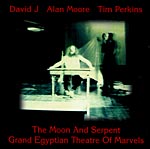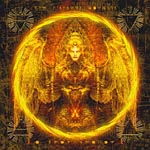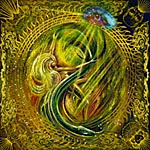>> Thumbnail: Alan Moore
>> Snake Charmer: An interview with Alan Moore, Part Two
More...

In 1994, Alan Moore announced to the world that he was dedicating his life to magic and had begun worshipping a snake. Amid puzzled looks from fanboys patiently awaiting a sequel to KILLING JOKE and scoffs from the magic-with-a-'K' community, Moore embarked on a string of new projects, including a full-length novel (VOICE OF THE FIRE) and a series of powerful mixed-media performances.
With a troupe of like-minded individuals that he dubbed "The Grand Egyptian Theatre of Marvels" (which included New Age musician Tim Perkins and former Bauhauser David J), Moore began constructing elaborate multimedia happenings, often inspired by the exact place and time of the performance itself. The shows were sensory experiences, featuring fiercely experimental music, avant-garde film collages and Middle Eastern dancers, and even a ghost, though that only made the rehearsals.
Over time, it became clear that the performances had become Moore's chosen medium for expressing his spiritual beliefs and philosophies in their purest form, undiluted by narrative restrictions or editorial guidelines. These were stark works - labyrinthine prose poems that attempted to explain the very nature of the universe itself. They were beautifully constructed, emotionally charged, and more than a little creepy.
His latest performance piece, the North London-inspired SNAKES AND LADDERS, has just been released on CD through Steven Severin's Re:Records.
SNAKES AND LADDERS is a story of spiritual awakening told through the eyes of 19th century pulp novelist Arthur Machen. Where did the fascination with Machen come from, and what inspired the piece itself? "With the SNAKES AND LADDERS piece, it was a daylong event, a 'symposium of real magic' - although I think I'll be the judge of that - and we decided to try and do one of our performances that was entirely based on the place where the event would be taking place, which happened to be Red Lion Square in Holborn.
 "Working on my basic assumption, which is that every square metre on the planet is probably a repository of wonderful things if you dig deeply enough, we got to work researching the square - trying to find out what, if anything, was interesting about it.
"Working on my basic assumption, which is that every square metre on the planet is probably a repository of wonderful things if you dig deeply enough, we got to work researching the square - trying to find out what, if anything, was interesting about it.
"So we started to dig up all this stuff, the stuff about the disinterment of Oliver Cromwell, and how his body was laid out in Red Lion Fields overnight; the fact that at least two or three of the major Pre-Raphaelites had lived there during one period; all of these other little threads, and the fact that Arthur Machen had been living on the Gray's Inn Road, which leads directly onto the square, just at the point where his wife had died and where, according to his autobiography, he'd had these peculiar visions, or shifts of state, probably brought on by the depression that followed his wife's death.
"The thing that's interesting about all of these performances, or at least interesting to me, is that you start with a fairly mundane area of London or Northampton or Newcastle or wherever you're doing it, and the unique character and essence of that area reveals itself to you. It's quite striking. I mean, Highbury is only a couple miles away from Holborn - they're both areas of North London - and yet when we started to dig into Highbury's past we found all of these very different kinds of energies represented.
"We found that there'd been freak shows, that there'd been an awful lot of people, from Aleister Crowley to the record producer Joe Meek, who'd been taking quite a lot of drugs. We found that this even extended to the 1925 Arsenal team, who had apparently been taking some sort of speed - must have been a prototype. They referred to them as 'courage pills'. We found that there was an awful lot of drugs, phantasmagoria, freak shows, ghost shows - there was a freakish atmosphere to Highbury. In Holborn, it seemed mostly to be about Death and Resurrection."
And love is a big theme in that one as well. "Love and Death and Resurrection. It's a different character. The character of Highbury is kind of freakish, garish, drugged, phantasmagoric. Holborn and Red Lion Square seem to have this natural Pre-Raphaelite palette, where it's all these images of love and death and resurrection. I don't think it's something we imposed upon the area; I think it's something that we revealed through our research into the area.
 "It's really interesting doing these things, you find that places definitely do have their own unique essence, made up of their history all of the rumours and legends about them - all of the people who passed through there, leaving a kind of historical imprint. You've just got layers and layers of historical meaning and mythological meaning that somehow go together to make the place what it is."
"It's really interesting doing these things, you find that places definitely do have their own unique essence, made up of their history all of the rumours and legends about them - all of the people who passed through there, leaving a kind of historical imprint. You've just got layers and layers of historical meaning and mythological meaning that somehow go together to make the place what it is."
What are the advantages to performing these works live, as opposed to just writing a book? "Well, that's partly to do with how the things originated. About ten years ago now, in 1993, when I turned 40, I suddenly decided to announce that I'd become a magician, just for a bit of a laugh really. But everyone took me seriously, so then I had to actually do some magic. I had initial experiences which seemed, at least in my book, to be magical experiences.
"As with most things in my life, I will try to process them in some creative way. Having had all of this extraordinary new information pouring into my head as a result of this magical experience, my first thought was 'How do I process this?' Following a kind of instinct, along with a couple of other friends who were experimenting with magic of a similar bent, it kind of felt that the most natural way to express some of the ideas I was receiving on account of the magic was in some sort of mixed-media performance.
"At the time I hadn't realised that a lot of significant magicians in the past had done exactly the same thing. Aleister Crowley did a kind of theatrical, musically-accompanied, mixed media ritual called THE RITES OF ELEUSIS, SL MacGregor Mathers had performed THE RITES OF ISIS - even John Dee back in the 16th century had frightened everybody with a mechanical flying beetle he had produced for one of the Greek dramas."
Moore noted that this practice was even more widespread than he thought. "The biggest thing that I found out was that Opera itself originated as an outgrowth of alchemy. That people like Monteverde, who were basically the fathers of opera - they were alchemists. They'd conceived opera as kind of an ultimate art form because it included all of the others. There'd be a libretto, so that there'd be words; there'd be music; there'd be painted sets; there'd be costumes; there'd be theatrical drama.
"Apparently, this is also why so many of the early operas have alchemical themes. Whether it's THE RING CYCLE, with all the trolls and the gold in the North, or THE MAGIC FLUTE, opera originated as kind of a mixed-media performance vehicle to get across magical ideas. It seems like it's a natural way that people came up with to express magic - in these kinds of overwhelming performances."
 Will an audience listening to a CD of an Alan Moore performance be sufficiently overwhelmed, not having the benefit of the multimedia aspects? "Well, obviously, it would be better if they saw the whole performance. But I think that, because there is so much in the words and the music - those are the main parts of the performance - that it's still easy to get an approximation of the night. Yes, it probably would have been more powerful if they had a fire-breather in their living room with them. That probably would have gotten them to sit up and pay attention. But they can probably get the gist of it with a CD.
Will an audience listening to a CD of an Alan Moore performance be sufficiently overwhelmed, not having the benefit of the multimedia aspects? "Well, obviously, it would be better if they saw the whole performance. But I think that, because there is so much in the words and the music - those are the main parts of the performance - that it's still easy to get an approximation of the night. Yes, it probably would have been more powerful if they had a fire-breather in their living room with them. That probably would have gotten them to sit up and pay attention. But they can probably get the gist of it with a CD.
"I think this kind of multimedia thing is entirely natural, thinking about it, because if you look at most of our religions - the Catholic Church, for example - in the kind of 'high ritual' Catholic Mass; you can see a multimedia performance there. You've got the incantations, you've got the impressive, resonant music; you've got the light show of the stained glass window; you've got the perfumed incense. We use incense at some of our performances, just to try to engage and, to a degree, overload all of the senses.
"The actual experience is very much like psychedelic drugs, like your head is suddenly receiving information on sixteen channels at once. It's a bit like listening to a musical fugue, where if you try to follow just one of the voices, you can't hear the overall music. So the best way to deal with a fugue, or the sort of 'fugue state' that LSD provokes, is to just not worry about processing it in your normal linear way. Just let it wash over you.
"I think that there's things in common between the sort of things that we do, opera, and high Catholic ritual. It's all working upon similar principles."
How comfortable is Alan performing these pieces for an audience that may or may not get it, for people that might have just have come because he's the guy who wrote WATCHMEN? "I'm very comfortable in practice, because actually, these performances... I don't know if you do get the full effect off of the CD, but they're quite riveting. I'm sure there have been members of those audiences who have come along because I wrote WATCHMEN, but you can generally get a pretty good feel as to how the audience is receiving it.
"As yet, there's not been a bad performance. If you're in a rock band and you're performing the same set every night, you're going to have good nights and you're going to have bad nights. But there just seems to be something about these one-off performances, where you're never going to do it again and you haven't rehearsed it countless times before - there seems to be something that gives an intensity and an immediacy to the performance, just by virtue of the fact that it is a completely unique event that will not be repeated. [The audience] seem to be fairly spellbound.
"During a lot of these performances, there have been a lot of other performances that they probably came to see. During the William Blake performance there was Billy Bragg and Jah Wobble and Deepspace and this weird supergroup that was made up of Glen Matlock from the Sex Pistols, Dave Rowntree from Blur, and Ewan McGregor. The people at these events - a lot of them haven't come to see me at all.
"But I think we're getting quite good at this performance business. We can generally hold an audience and - I think - captivate them for 40 minutes or an hour or however long the performance takes. And if they did enjoy WATCHMEN, and came to see what I was like in the flesh, then hopefully they'd have gotten an experience that in many ways was every bit as interesting as WATCHMEN. That's what I hope anyway."
In part two, Alan Moore talks about Eddie Campbell, VOICE OF THE FIRE, and the end of his comics career.

This article is Ideological Freeware. The author grants permission for its reproduction and redistribution by private individuals on condition that the author and source of the article are clearly shown, no charge is made, and the whole article is reproduced intact, including this notice.


